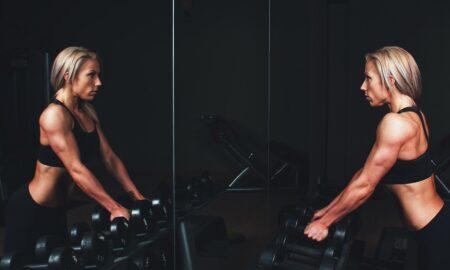I don’t give much thought to shoulder presses. I’ve always had pretty decent deltoids, and I’ve always been very strong on any type of overhead press. Recently, I read something that piqued my curiosity and caused me to rethink my presses for the first time in years.
Marty Gallagher, a columnist for The Washington Post and a world-champion powerlifter who’s probably forgotten more about weight training than most people know, commented that standing presses for shoulders have gone the way of the dinosaur over the past three decades. Most bodybuilders and serious weight trainers today have never even done them. Today a lot of people press on Smith or Hammer Strength or LifeFitness machines. Plenty of guys press with barbells and dumbbells but always seated on a bench with back support.
What’s so wrong with that? Well, when I press while seated on a bench, I can move a lot of iron, but I also arch my back and lean back quite a bit when I get to my heaviest weights. I’ve pressed 140-pound dumbbells for a few reps, and I’ve pressed 275 on a barbell to the front for a few reps—but always with compromised form. My wife, Janet, used to rip on me for what she perceived as horrendous technique and said I was working more upper chest than shoulders. My witty comeback was, “You can never have too much upper chest development.”
Aside from the lean-back form, there was another problem. My shoulders have been feeling the wear and tear of well over two decades of heavy training. It’s becoming clear to me that, whether I like it or not, the years are catching up to me and I can’t train so heavy all the time.
Marty talked about the old-time bodybuilders who all did standing presses with dumbbells and barbells, and the shoulder development of those men was typically sensational. Picture the broad, cannonball delts of John Grimek, Clancy Ross, Armand Tanny and Steve Reeves. If you’ve seen “Pumping Iron,” you should also recall two memorable workout scenes involving standing presses that featured Mike Katz and Lou Ferrigno grunting, “Arnold! Arnold!” with each rep. Both of them owned some of the best shoulders of their era.
Pressing in a standing position is much tougher because you’re forced to keep yourself balanced, which forces your shoulders to work much harder than they would if you were nicely supported by a bench and back support. I’ve tried standing presses with a barbell many times, and they never felt quite right. A certain amount of leaning back was needed just so the bar didn’t whack my jaw or nose as I pressed. It was the lean that actually caused the overhead press to be dropped as an Olympic lift in 1972. I always felt that I was going to fall backward. Dumbbells make a lot more sense to me.
Because you hold dumbbells directly over your shoulders rather than in front of or behind them, it’s much easier to maintain a perfect upright position. When I decided to give standing dumbbell presses a try, I warmed up with a pair of 30s for 12, then 40s for six and then did my work sets. I got 50s for 15, 60s for 12 and 60s for a final 10. I could have gone a bit heavier, but not much. It’s odd, because 60s and 70s are a warmup weight for me when I do my overhead presses seated. Standing, they were plenty heavy! The real proof that I was on to something came only hours later. I thought I’d hurt my shoulders somehow and was worried that an emergency visit to the chiropractor was called for—but no, it was just that my deltoids were already getting sore, something that hadn’t happened to me in more than a year.
So I’d give the big thumbs-up to standing dumbbell presses. Just be sure you don’t attempt to use as much weight as you do when you perform the exercise sitting down. It ain’t gonna happen. The slight wound to your ego due to the lighter dumbbells will be just a distant memory once the soreness kicks in—and you find your shoulders growing wider, thicker, rounder. IM
Editor’s note: Ron Harris is the author of Real Bodybuilding, available at www.RonHarrisMuscle.com.




















You must be logged in to post a comment Login